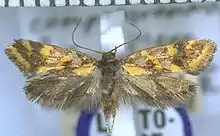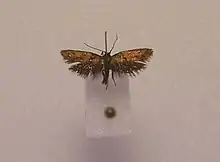| Tingena compsogramma | |
|---|---|
 | |
| Male lectotype | |
| Scientific classification | |
| Domain: | Eukaryota |
| Kingdom: | Animalia |
| Phylum: | Arthropoda |
| Class: | Insecta |
| Order: | Lepidoptera |
| Family: | Oecophoridae |
| Genus: | Tingena |
| Species: | T. compsogramma |
| Binomial name | |
| Tingena compsogramma | |
| Synonyms[2] | |
| |
Tingena compsogramma is a species of moth in the family Oecophoridae.[2] It is endemic to New Zealand and has been observed in the North and South Islands. This species inhabits native forest and adults are on the win from December until March.
Taxonomy

This species was first described by Edward Meyrick in 1920 using specimens collected by George Hudson along the Buller River in December and named Borkhausenia compsogramma.[3] George Hudson discussed and illustrated this species under the same name in his 1928 publication The butterflies and moths of New Zealand.[4] In 1988 J. S. Dugdale placed this species in the genus Tingena.[2] The male lectotype specimen is held at the Natural History Museum, London.[2]
Description
.jpg.webp)
Meyrick described this species as follows:
♂. 13-15 mm. Head, thorax, and abdomen dark purplish-fuscous. Antennal ciliations 1. Palpi grey, second joint sometimes partially suffused with whitish-yellowish. Forewings elongate, costa gently arched, apex obtuse, termen obliquely rounded ; dark violet-fuscous ; markings ochreous-yellow suffused in disc with fulvous-orange, and with some scattered blackish scales on their edges ; an oval blotch extending over basal fourth of dorsum ; a narrow irregular rather oblique fascia from costa before 1⁄3, not reaching dorsum ; a transverse fasciate blotch from costa beyond middle, and another inwardly oblique from costa at 4⁄5, both directed towards but not reaching a spot on dorsum before tornus ; a streak along termen throughout : cilia fuscous, base scaled with ochreous-yellow along terminal streak. Hindwings and cilia dark grey.[3]
This species is variable in the intensity of its forewing markings and as well as ground colour.[4] It is similar in appearance to T. chrysogramma but is distinct.[4]
Distribution
This species is endemic to New Zealand and has been observed in the North Island, including at Mount Ruapehu and at Kaitoke, and in the South Island, including in Otago at the Humboldt Range, Lake Wakatipu and at the Hunter Mountains.[1][4]
Behaviour
Adults of this species are on the wing from December until March.[4]
Habitat
This species inhabits native forests often at altitude.[4]
References
- 1 2 Gordon, Dennis P., ed. (2010). New Zealand inventory of biodiversity: Kingdom animalia : chaetognatha, ecdysozoa, ichnofossils. Vol. 2. p. 462. ISBN 978-1-877257-93-3. OCLC 973607714. OL 25288394M. Wikidata Q45922947.
- 1 2 3 4 John Stewart Dugdale (23 September 1988). "Lepidoptera - annotated catalogue, and keys to family-group taxa". Fauna of New Zealand. Department of Scientific and Industrial Research. 14: 100. doi:10.7931/J2/FNZ.14. ISSN 0111-5383. Wikidata Q45083134.
- 1 2 Edward Meyrick (1920). "Descriptions of New Zealand Lepidoptera". Transactions and Proceedings of the New Zealand Institute. 52: 31. ISSN 1176-6158. Wikidata Q110309972.
- 1 2 3 4 5 6 George Vernon Hudson (1928), The butterflies and moths of New Zealand, Illustrator: George Hudson, Wellington: Ferguson and Osborn Limited, p. 261, LCCN 88133764, OCLC 25449322, Wikidata Q58593286